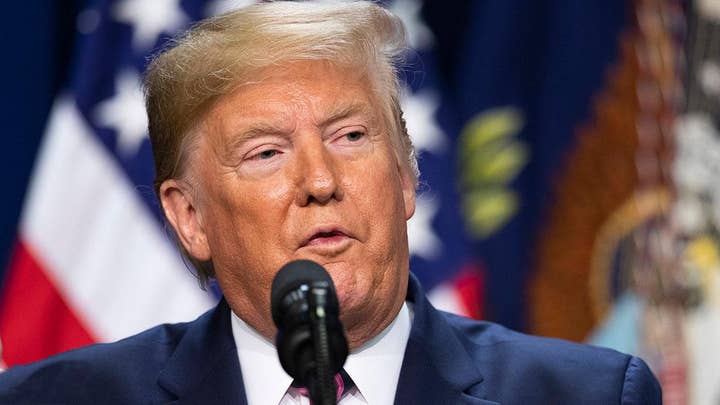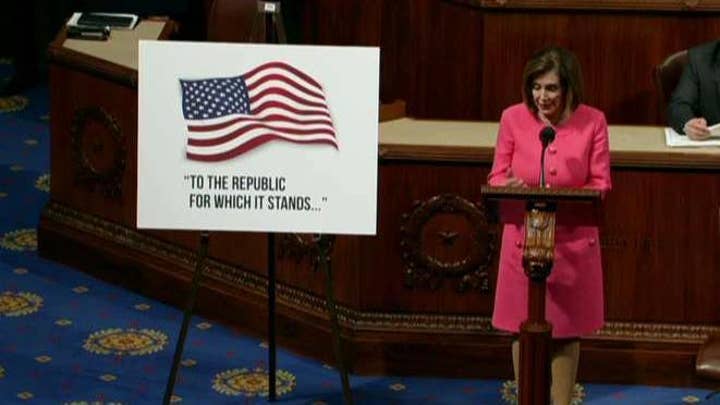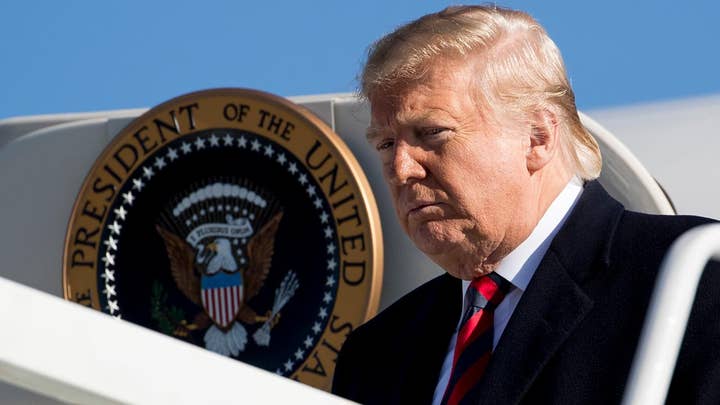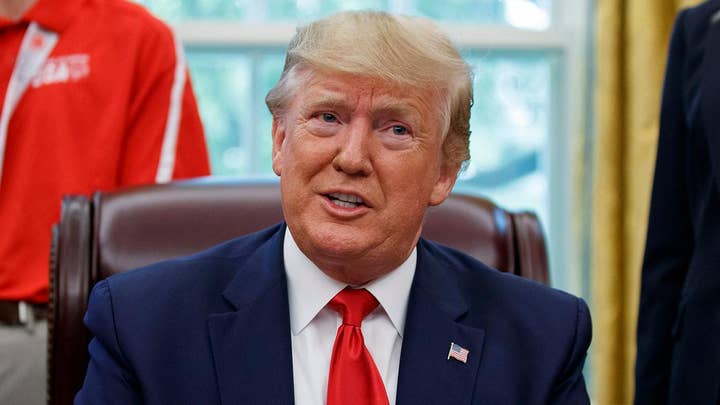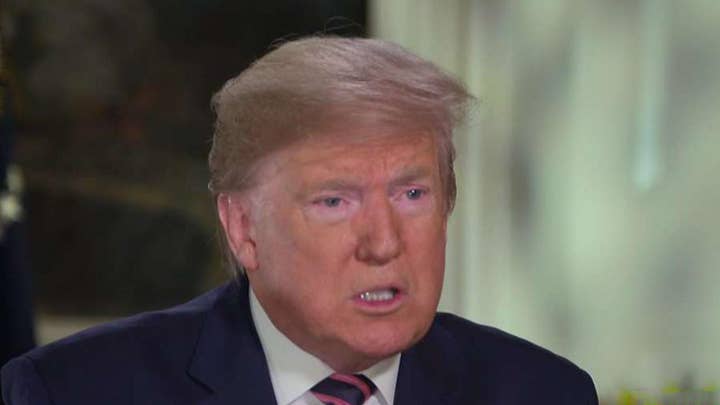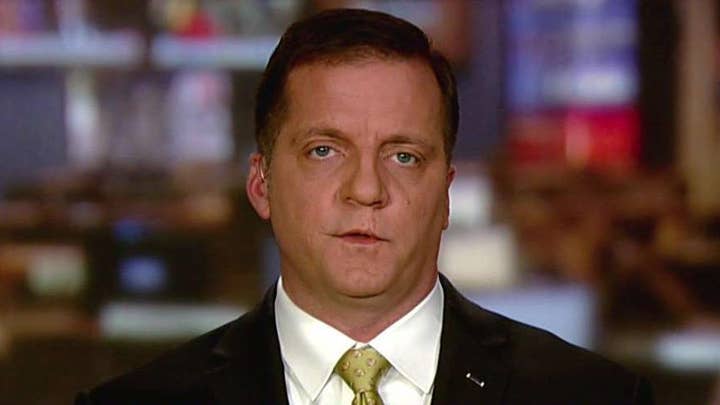Trump preparing to deliver State of the Union address ahead of final impeachment vote
President Trump is expected to highlight the administration's accomplishment and maintain a positive message; Gillian Turner reports from the White House.
Every president’s time in office is marked by high points and low points, but for President Trump there seemed to be no middle ground over the last 365 days. With a divided and highly-partisan Congress, a slew of crises both domestic and foreign, and a fast-approaching general election, Trump’s 2019 was anything but tranquil.
With his third State of the Union address only hours away, here is a look at Trump’s successes and setbacks since he last addressed Congress.
SUCCESSES
USMCA
A major policy proposal Trump has been pushing since his time running for election in 2016 was getting rid of and replacing the 25-year-old North American Free Trade Agreement, known as NAFTA. Trump blamed the pact for encouraging U.S. companies to move their manufacturing plants south of the border to take advantage of low-wage Mexican laborers.
So when the Senate approved in January a new trade bill, which has come to be called USMCA, the president got a major policy victory right before his impeachment trial was slated to start. Among other things, the agreement aims to have more cars produced in the United States, where workers earn an average of at least $16 an hour. It also secured changes that require Mexico to change its laws to make it easier for workers to form independent unions, which should improve worker conditions and wages and reduce the incentive for U.S. companies to relocate their plants.
China trade deal
What could have been a disaster for his administration and threatened to throw the economy into a downward spiral, ultimately ended up as a win for Trump. After 18 months of trade combat, the U.S. and China agreed to an interim truce in their trade war.
The centerpiece of the deal is China’s vow to buy an extra $200 billion worth of U.S. manufacturing, energy and farm exports this year and next. The mandated purchases are unusual for modern trade agreements. Trade pacts now usually set the rules for commerce but let customer demand sort out who buys how much of what.
As part of the so-called Phase 1 deal, Trump scrapped his plan to impose tariffs on $160 billion in Chinese imports, and he halved his import taxes on an additional $110 billion worth. (The administration still maintains tariffs on $360 billion in Chinese products, and Beijing has imposed retaliatory tariffs on U.S. exports.) In return, China agreed to do more to protect intellectual property and to curb its practice of forcing foreign companies to hand over trade secrets as the price of admission to the Chinese market.
Death of Abu Bakr al-Baghdadi
Arguably the biggest military victory for Trump in 2019 was the raid that led to the death of ISIS leader Abu Bakr al-Baghdadi.
Al-Baghdadi, who took over ISIS after his predecessor Abu Omar al-Baghdadi was killed in 2010, detonated a suicide vest, killing himself in October shortly after U.S. Special Operations forces entered a compound in northern Syria where he was located.
Trump said the U.S. had been searching for al-Baghdadi for years, calling his capture or death “the top national security priority of my administration.” Trump thanked Russia, Turkey, Syria, Iraq, and Kurds in the region.
“No personnel were lost in the operation, while a large number of Baghdadi’s fighters and companions were killed with him,” Trump said, adding that the U.S. recovered “highly sensitive” materials related to ISIS. “You are the very best anywhere in the world,” Trump later said of the U.S. forces.
Economy
The surging U.S. economy has been one of Trump’s main talking points when stumping for his reelection – touting low unemployment figures across the board, job creation and promising economic growth numbers. There is the saying that Americans vote with their wallets and, if that’s the case, Trump’s hopes of reelection are looking good.
While there may appear to be storm clouds on the horizon that he will have to deal with in the coming months – namely a recent slowing of economic growth and a continually growing national deficit -- Trump is still expecting to have the economy rolling as he heads in the election year.
“We’ve never had an economy like the one we have now, and that happens through causation, not coincidence,” Counselor to the president Kellyanne Conway told Fox News, noting that the Trump administration wants to “bring along American public opinion so that they can understand” their policies.
Federal judges confirmed
As of mid-January, 187 federal judges and two Supreme Court Justices had been confirmed during Trump's presidency with Senate Majority Leader Mitch McConnell saying that one out of every four circuit judges was appointed by Trump and confirmed by the Senate.
Trump has appointed 50 circuit court judges so far while former President Obama successfully nominated only 55 in eight years in office, according to The Washington Post.
The Ninth Circuit in particular, which Trump has railed against as a “big thorn in our side” due to its liberal bent, has seen a dramatic change in its makeup over the past three years, with 10 of its 29 active seats now being held by Trump appointees, and nearly half being held by appointees of Republican administrations.
SETBACKS
Impeachment
In late December, Trump became only the third president in U.S. history to be impeached. While there is little chance that the Republican-controlled Senate will vote to remove him from office, the stain of impeachment will still play heavily into Trump’s legacy and will certainly be a talking point for his rivals in the 2020 election.
Pair this with allegations raised by people who were hindered from testifying during the Senate impeachment trial and the president’s actions – for which he was impeached on charges of abuse of power and obstruction of Congress – are likely to be debated long after he leaves the White House.
Tax return lawsuit
A federal judge in November dismissed Trump's lawsuit that attempted to block a newly passed law that would allow Congress to obtain his New York state tax returns.
The law, known as the TRUST Act, was signed by Gov. Andrew Cuomo in July and calls for the commissioner of the New York State Department of Taxation and Finance to release the president's tax returns if requested by the chair of the House Ways and Means Committee, Senate Finance Committee, or the Joint Committee on Taxation.
Trump argued that the law poses a First Amendment issue, claiming that it targets him due to his political beliefs and speech. New York Republicans also opposed the law, claiming that is what is known as a "bill of attainder" – meaning one that singles out an individual for punishment – which is prohibited by the Constitution.
The language of the law does not mention Trump at all, but Democrats like state Sen. Brad Hoylman, who sponsored a version of the bill, and House Judiciary Committee Chairman Rep. Jerrold Nadler, D-N.Y., specifically mentioned Trump in reference to the legislation before it passed. Nadler described it in the context of House Democrats' quest to get Trump's tax returns, calling it "a workaround to a White House that continues to obstruct and stonewall the legitimate oversight work of Congress."
Efforts to implement citizenship question
The Supreme Court over the summer ruled against the Trump administration's push to included a citizenship question on the 2020 Census, forcing the administration to start printing census forms without the controversial question on it.
While the court did leave open the possibility that the administration could provide an adequate argument, the deadline to begin printing census forms was quickly approaching so the Justice Department said that the administration would not continue to plead its case. The move was not just a setback for Trump's plans to crack down on illegal immigration, but also could affect redistricting in certain key congressional districts for the midterm elections in 2022.
Court rulings against immigration policies
While Trump did score some victories on his immigration policies - notably the Supreme Court allowing the administration to enforce its "public charge" immigration restriction -- a federal judge last month blocked the enforcement of Trump’s executive order that would allow state and local officials to opt-out of accepting refugees.
Trump issued the executive order in September saying that the federal government would only resettle refugees if states and local governments had consented to do so — giving states a de facto veto over whether they would resettle refugees.
The executive order is one of a number of immigration policies that have been put on ice by the courts. The Justice Department last month also filed an emergency request to the Supreme Court to have injunctions lifted on the Trump administration’s proposed rule that would restrict green cards for immigrants who are deemed likely to be reliant on welfare.
Deal on tougher gun laws after mass shootings
Following a pair of horrific mass shootings last year in Dayton, Ohio and El Paso, Texas, President Trump and Democrats tried to work together to pass some sort of meaningful gun control legislation.
But the move fell apart amid demands by the House to expand background checks for gun purchases and an unwillingness by Senate leaders to move forward.
Senate Majority Leader Mitch McConnell, R-Ky., declined to hold a vote on the bill, which was approved by the Democratic-controlled House in February. His argument was that it's not clear the Senate would be able to pass the legislation or that Trump would sign it into law.
OUTCOME UNCLEAR
Iran
This year began for Trump with an escalation of tensions between the U.S. and Iran following an American drone strike that killed a top Iranian general in Iraq. Relations between Washington and Tehran were already tense following Trump’s move to pull out of the Obama-era Iranian nuclear deal, but things got even worse following the drone strike.
Iran retaliated with a missile strike of their own and while things stopped short of an all-out war, tensions between the two nations remain high.
Border Wall
The construction of a massive wall along the U.S.’s southern border with Mexico was arguably Trump’s biggest campaign promise in 2016. And despite 100 miles of his wall being constructed, the border wall appears to be far from complete.
Courts and Congress have fought tooth-and-nail against Trump’s hardline immigration policies and even declaring a national emergency hasn’t allowed the president to speed up construction of the controversial wall.
Trump is still vowing to fulfill his promise: The administration has promised to complete 450 miles of new border wall by the end of 2020.
Fox News' Brooke Singman, Ronn Blitzer and The Associated Press contributed to this report.

























